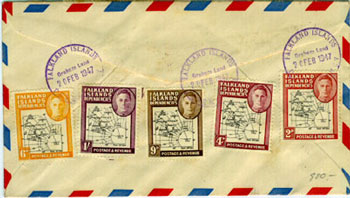|
|
|
The USS EDISTO cover illustrated to your left gives
a view of the entire cover bearing both the printed cachet, designed
by Walter F. Holtgreve,
and the special cancel. A closer look at the cachet clarifies
the wording, the dotted course of the vessels, the reference points
and the initials of the cachet designers. The cachet was printed
in green, of which several shades are known.
The initial covers serviced had the
wording South / Pole / 1947-48 between the killer bars.
However, when the participants realized the South Pole would certainly
never be apropos for the expedition, the wording was changed to
read Little / America / 1947-48, which actually was visited
between January 31 and February 5, 1948. . .
If you look closely, just above the
point of the red arrow, you can spot the initials of the cachet
designers, Glen R. Krause (who participated
on Windmill) and Walter F. Holtgreve.
|
|
It
should most definitely be mentioned here that regular mail exists
from the USS EDISTO during the cruise bearing the
ships official canceling device without wording between the
killer bars. Uncacheted covers of this type are known from November
6, 1947 (when the vessel departed Norfolk, VA) up until late March
1948 when she returned to that same port.
Elusive as the
covers are from the USS EDISTO during this cruise,
they can be considered relatively common when compared to the availability
of those found from the USS BURTON ISLAND (AG-88)
which accompanied the USS EDISTO. Most importantly,
there are no known printed covers which bear the USS BURTON
ISLAND cancel. The few covers known from this vessel during
the expedition are uncacheted and generally have cancellation dates
of late March, 1948, when she was approaching her home port of San
Pedro, CA, which was reached on April 1, 1948. Extremely lucky is
the collector who can show a USS BURTON ISLAND cover
canceled while the vessel was in Antarctic waters. . .
|
|
|
USS BURTON ISLAND
AT LITTLE AMERICA
Upon arrival at the
Bay of Whales on January 31, 1948, then only 100 yards wide, the
ships moored against the bay ice and parties went ashore. The
Weasels were hoisted out and for the next five days, Captain Boyd,
USMC and Ensign Mallory directed studies of the structures and
equipment left at the former bases, Little America III (1940)
and IV (1947). The USS BURTON ISLAND called all
parties back to the ship on February 5.
|
|
|
RESCUE OF THE
RONNE EXPEDITION
Since
1939, the only privately organized expedition from the United
States has been the RONNE ANTARCTIC RESEARCH EXPEDITION..
Ronne's expedition was quite small when compared to scientific
expeditions of today. However, significant accomplishments were
made during the expedition. A number of governmental agencies,
including the Army, Navy and Air Force helped in making the expedition
possible, particularly by providing equipment. Individuals from
other government agencies provided advice and assistance as well.
The expedition's Main Base was set up on Stonington Island, Marguerite
Bay, in the buildings used as East Base during Byrd's 3rd Antarctic
expedition, the UNITED
STATES ANTARCTIC SERVICE EXPEDITION 1939-41. This
vicinity was also home to the Falkland Islands Dependencies "Base
E" campsite, under the command of Major K. S. Pierce-Butler.
A very good relationship was established between the men and as
a consequence, some scientific work was shared between the groups.
In January 1948, preliminary preparations were made to bring the
expedition to an end.
|
| Departure
had originally been planned for mid-March, as Ronne assumed the bay
ice would be clear enough for their ship, PORT OF BEAUMONT,
to get out. Cold weather returned in February, indicating an early
Antarctic autumn, risking the probability of another ice-locked winter
season. At the same time, the U.S. Navy Task Force 39, consisting
of the icebreakers USS BURTON ISLAND and USS
EDISTO were approaching the vicinity of Marguerite Bay on
their way home from the conclusion of OPERATION
WINDMILL . As a result of conversations between Ronne
and Commander Gerald Ketchum, USN, of the Task Force, it was agreed
that the icebreakers would come to Stonington Island to break a passage
for the PORT OF BEAUMONT to open water. The operation
was a success, having been accomplished on February 20, 1948. This
cover, officially an OPERATION WINDMILL cover, was run
ashore, and posted at the Falkland Islands Dependencies "Base
E" on the day the USS BURTON ISLAND broke through.
To make things even more interesting, the year date is incorrectly
applied (1947 rather than 1948). |
 REVERSE OF
THE ABOVE COVER
REVERSE OF
THE ABOVE COVER |
|

